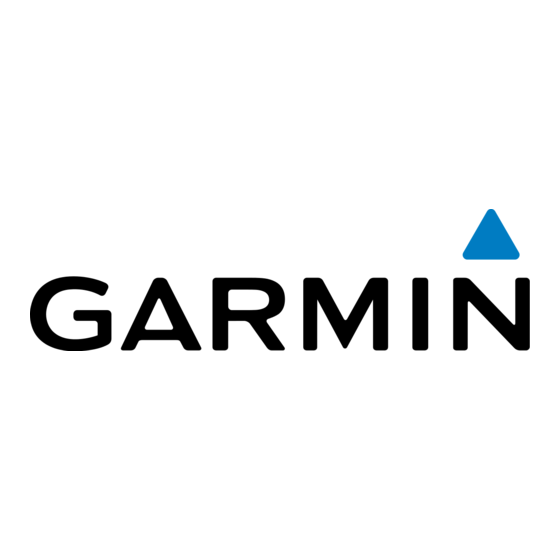Garmin ECHOMAP PLUS 90 series Manual do Proprietário - Página 43
Procurar online ou descarregar pdf Manual do Proprietário para Sistema GPS marítimo Garmin ECHOMAP PLUS 90 series. Garmin ECHOMAP PLUS 90 series 50 páginas. Navigation portable plus for bmw
Também para Garmin ECHOMAP PLUS 90 series: Manual do Proprietário (40 páginas), Manual de instruções de instalação (6 páginas), Manual de início rápido (8 páginas), Manual de instruções de instalação (6 páginas)

Wi‑Fi Network
‑ Fi Wireless Network
Setting Up the Wi
The chartplotters can create a Wi‑Fi network to which you can
connect wireless devices. The first time you access the wireless
network settings, you are prompted to set up the network.
1
Select Settings > Communications > Wireless Devices >
Wi-Fi Network > Wi-Fi > On > OK.
2
If necessary, enter a name for this wireless network.
3
Enter a password.
You will need this password to access the wireless network
from a wireless device. The password is case-sensitive.
Connecting a Wireless Device to the Chartplotter
Before you can connect a wireless device to the chartplotter
wireless network, you must configure the chartplotter wireless
network
(Setting Up the Wi
You can connect multiple wireless devices to the chartplotter to
share data.
1
From the wireless device, turn on the Wi‑Fi technology and
search for wireless networks.
2
Select the name of your chartplotter wireless network
‑ Fi Wireless Network, page
Up the Wi
3
Enter the chartplotter password.
Changing the Wireless Channel
You can change the wireless channel if you have trouble finding
or connecting to a device, or if you experience interference.
1
Select Settings > Communications > Wi-Fi Network >
Advanced > Channel.
2
Enter a new channel.
You do not need to change the wireless channel of devices
connected to this network.
Setting Alarms
Navigation Alarms
Select Settings > Alarms > Navigation.
Arrival: Sets an alarm to sound when you are within a specified
distance or time from a turn or a destination.
Anchor Drag: Sets an alarm to sound when you exceed a
specified drift distance while anchored.
Off Course: Sets an alarm to sound when you are off course by
a specified distance.
System Alarms
Alarm Clock: Sets an alarm clock.
Device Voltage: Sets an alarm to sound when the battery
reaches a specified low voltage.
GPS Accuracy: Sets an alarm to sound when the GPS location
accuracy falls outside the user-defined value.
Setting the Fuel Alarm
Before you can set a fuel level alarm, a compatible fuel flow
sensor must be connected to the chartplotter.
You can set an alarm to sound when the total amount of
remaining onboard fuel reaches the level you specify.
1
Select Settings > Alarms > Fuel > Set Total Fuel Onboard
> On.
2
Enter the remaining amount of fuel that triggers the alarm,
and select Done.
Units Settings
Select Settings > Units.
System Units: Sets the unit format for the device.
Device Configuration
‑ Fi Wireless Network, page
37).
Variance: Sets the magnetic declination, the angle between
magnetic north and true north, for your present location.
North Reference: Sets the direction references used in
calculating heading information. True sets geographic north
as the north reference. Grid sets grid north as the north
reference (000º). Magnetic sets the magnetic north as the
north reference.
Position Format: Sets the position format in which a given
location reading appears. Do not change this setting unless
you are using a map or chart that specifies a different
position format.
Map Datum: Sets the coordinate system on which the map is
structured. Do not change this setting unless you are using a
map or chart that specifies a different map datum.
Pressure Reference Time: Sets the reference time used to
calculate the barometer trend. The trend is indicated in the
37).
barometer field.
Time Format: Sets a 12-hour, 24-hour, or UTC time format.
Time Zone: Sets the time zone, or allows automatic selection
based on GPS location.
(Setting
Navigation Settings
NOTE: Some settings and options require additional charts or
hardware.
Select Settings > Navigation.
Route Labels: Sets the type of labels shown with route turns on
the map.
Auto Guidance: Sets the parameters the chartplotter uses
when calculating an Auto Guidance path, when you are using
some premium maps.
Turn Transition Activ.: Sets the turn transition to be calculated
based on time or distance.
Turn Transition Time: Sets how many minutes before the turn
that you transition to it as the next leg, when Time is selected
for the Turn Transition Activ. setting. You can raise this value
to help improve the accuracy of the autopilot when navigating
a route or an Auto Guidance path with many frequent turns or
at higher speeds. For straighter routes or slower speeds,
lowering this value can improve autopilot accuracy.
Turn Transition Dist.: Sets how far before the turn that you
transition to it as the next leg, when Distance is selected for
the Turn Transition Activ. setting. You can raise this value to
help improve the accuracy of the autopilot when navigating a
route or an Auto Guidance path with many frequent turns or
at higher speeds. For straighter routes or slower speeds,
lowering this value can improve autopilot accuracy.
Route Start: Selects a starting point for route navigation.
Other Vessel Settings
When your compatible chartplotter is connected to an AIS
device or VHF radio, you can set up how other vessels are
displayed on the chartplotter.
Select Settings > Other Vessels.
AIS: Enables and disables AIS signal reception.
DSC: Enables and disables digital selective calling (DSC).
AIS Alarm: Sets the collision alarm
Collision Alarm, page 8
Alerts, page
Restoring the Original Chartplotter Factory
Settings
NOTE: This affects all devices on the network.
1
Select Settings > System > System Information > Reset.
(Setting the Safe-Zone
and
Enabling AIS Transmission Test
8).
37
